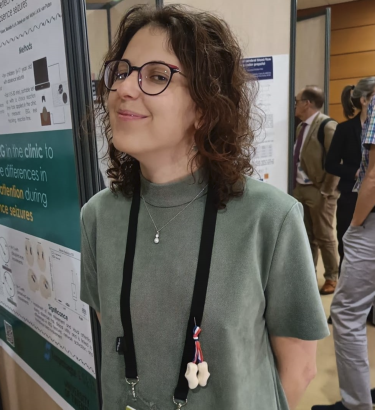Neurophysiological signatures of visual attention in absence epilepsy and mild traumatic brain injury
Valentina Barone is a PhD student in the department Clinical Neurophysiology. (Co)promotors are prof.dr.ir. M.J.A.M. van Putten from the faculty of Science and Technology and dr.ing. J.P. van Dijk from Eindhoven University.
 Visual attention, the cognitive process of selectively focusing on pertinent visual information while filtering out unimportant stimuli, is a fundamental function of the human brain. Understanding visual attention and its mechanisms is relevant in clinical contexts and can significantly benefit healthcare professionals. Multiple brain areas are involved in the functioning of visual attention. As a result, visual attention can deteriorate in the presence of various brain disorders. Symptoms associated with impaired visual attention can be overlooked, particularly when they are not easily identifiable, such as impaired eye movements or delayed response to stimuli. Disturbances in visual attention can significantly disrupt patients’ daily lives and potentially pose risks. By examining neurophysiological readouts related to visual attention, medical professionals can enhance diagnostic accuracy and evaluation, create precise rehabilitation approaches, predict outcomes, and make valuable contributions to the progression of cognitive neuroscience and clinical neurophysiology research.
Visual attention, the cognitive process of selectively focusing on pertinent visual information while filtering out unimportant stimuli, is a fundamental function of the human brain. Understanding visual attention and its mechanisms is relevant in clinical contexts and can significantly benefit healthcare professionals. Multiple brain areas are involved in the functioning of visual attention. As a result, visual attention can deteriorate in the presence of various brain disorders. Symptoms associated with impaired visual attention can be overlooked, particularly when they are not easily identifiable, such as impaired eye movements or delayed response to stimuli. Disturbances in visual attention can significantly disrupt patients’ daily lives and potentially pose risks. By examining neurophysiological readouts related to visual attention, medical professionals can enhance diagnostic accuracy and evaluation, create precise rehabilitation approaches, predict outcomes, and make valuable contributions to the progression of cognitive neuroscience and clinical neurophysiology research.
In this dissertation, we focus on absence epilepsy (AE) and mild traumatic brain injury (mTBI) as prevalent neurological disorders with a significant impact on visual attention. Our research goal is to accurately measure visual attention in clinical settings. To this end, we developed a custom-built measurement setup to assess neurophysiological indicators of visual attention (Part I) in patients with absence epilepsy (Part II) and mild TBI (Part III). We address existent clinical requirements and establish a starting point to provide objective explanations of cognitive impairment to clinicians specialized in neurological patient care.
We show variable involvement of impaired visual attention in both absence epilepsy and mild traumatic brain injury. Notably, this impairment varies within the same populations. We identified distinct neurophysiological indicators that can help investigate cognitive impairment and neurological changes associated with these disorders. This thesis confirms the feasibility of a rapid and straightforward assessment of visual attention in clinical environments, which offers essential insights for clinicians, aiding them in clinical evaluation and prognosis.

